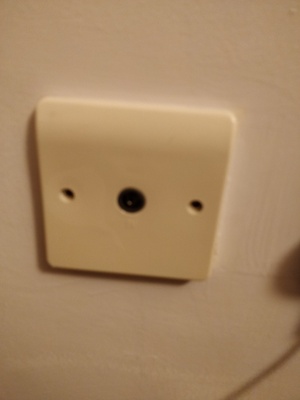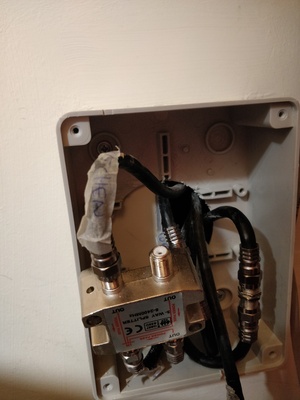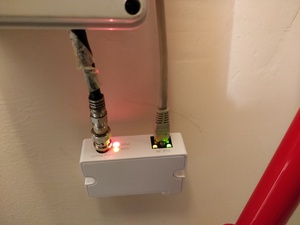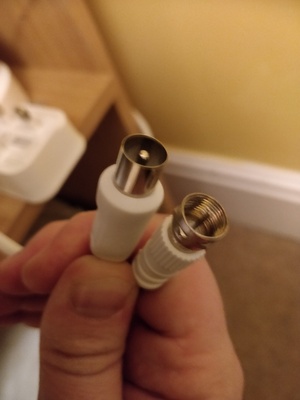Ethernet over coax
Like most of the world's office workers, I've been based at home for the majority of 2020. And one thing that's been bugging me is connectivity to my desk.
I have a pretty decent VDSL internet connection courtesy of A&A, which tops out close to the theoretical max of 80 megabits/sec down and 20 up. However, it comes into the flat in the opposite corner to my desk.
WiFi is perfectly possible, but video calls do sometimes stall and break up.
Ethernet over mains with the powerline adapters is a bit iffy, because unfortunately the socket in the "comms" cupboard is on a different ring to the ones in my spare bedroom/office. (Does a two bedroom flat really need two separate socket circuits? The builders of this one clearly thought so.) It sort-of works, but not at sufficient speed to max out the internet connection.
Obviously, in an ideal world, the flat would have data cabling to every room - I have friends in more modern new builds which have that as standard - but this place is a bit too old for that.
It does have telephone sockets in every room, wired in Cat5, but of course because it's just being used for telephone, they're daisy-chained rather than connected in a star topology. So it might be possible to joint loads of them together and get a data connection from one point to another - equally, it might be possible to break all the phone sockets and get deeply frustrated.
I did entertain some brief fantasies of rodding data cables through the hollow ceilings and walls, but there's realistically zero chance of getting across the flat without cutting some holes that would have to be made good afterwards.
Finally, though, inspiration struck. There is one form of cabling which is connected in a star topology back to the cupboard with the phone line in it, and serves points in every room...

TV cabling! Rather ridiculously, every room in this flat except the bathrooms has a TV aerial socket. Of course, the builders didn't wire them up correctly - when I moved in, this splitter had the inputs and outputs the wrong way round:

... but I fixed that long ago, even though I only have two TVs connected (including the bedroom one I never watch). I also worked out which feed was to which room and labelled them up, which came in handy.
So, then, could I use them to run ethernet? A bit of rummaging on Amazon, and I'm pleased to report that the answer is yes!
This is the "transmit" end in the cupboard - I've disconnected the spare bedroom's coax cable from the TV splitter and brought it out of the bottom of the junction box, since there wasn't quite room inside for the EoC transmitter:

These devices cost me £72.99 for the pair from Amazon - not cheap, but not outrageous. I also bought a couple of adapters to change the connectors on the units from BNC to a standard UK satelite presentation, which matches the connectors on the cables in the junction box. For the other end, I bought a cable which takes standard UK TV out of the wall and presents a Sky-type male coax connector.

Once it was all connected up, my laptop reported a 100mbps connection and could talk to the router straight away.
Since these devices don't claim to do gigabit, 100mbps is fair enough. I can certainly get close to maxing out my internet connection:

Other things to note? Well, these devices are targeted primarily at the CCTV market - they are supposed to make it easier to upgrade old coax based CCTV to modern power-over-ethernet systems. With that in mind, the "transmit" end requires power over ethernet to run - fortunately I had an old PoE injector to hand.
It alledgedly sends power down the coax and out of the other unit. I don't have any power-over-ethernet devices handy to test that claim with. However, I can confirm that it needs PoE to transmit data at all, so there must be active electronics in both ends doing the encoding - not terribly surprising.
All in all, a bit of a result for the money spent - less than £85 in total, and no irreversible alterations to the flat. Ten minutes and a screwdriver to set up.
It would start getting pricey if you wanted to join more than two points together (you'd need a pair of the devices for each link, and running more would really need a PoE switch at the distribution end), but for this particular job, a wired connection from the router to my office is all I wanted.